

DSV Sea Cliff. DSV-4 (ex-Sea Cliff) is a 25-ton, manned deep-ocean research submersible owned by the United States Navy.

It is sister to DSV Turtle (DSV-3), DSV Alvin (DSV-2), and also an Alvin class Deep Submergence Vehicle. The Sea Cliff was retired from active service in 1998 and subsequently given to Woods Hole Oceanographic Institution [1]. The Naval Vessel Register shows DSV-4 was returned to active service on September 30, 2002 in the custody of Woods Hole [2], but a New York Times article indicates that it was cannibalized for parts for DSV Alvin [3].
It is now known only by its hull number, not by name. The DSV-4 originally had a maximum dive depth of 6500 feet (2000 m), like all Alvin-class DSVs at first. See also[edit] Bathyscaphe Trieste II. Between September 1965 and May 1966, Trieste II again underwent extensive modification and conversion at Mare Island Naval Shipyard, but there is no clear record that she was ever operated in that new configuration, i.e., the addition of skegs or outriggers on both sides of the sphere.
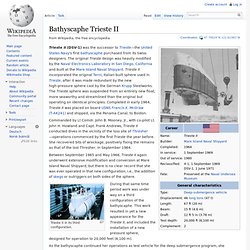
Trieste II in its third configuration. During that same time period work was under way on a third configuration of the bathyscaphe. This work resulted in yet a new appearance for the Trieste II, and included the installation of a new pressure sphere, designed for operation to 20,000 feet (6,100 m). As the bathyscaphe continued her operations as test vehicle for the deep submergence program, she qualified four officers as "hydronauts"—the beginning of a burgeoning oceanographic operation. Equipment configuration. This unique craft was listed only as "equipment" in the Navy inventory until the autumn of 1969. Trieste II is now preserved as a museum ship at the Naval Undersea Museum, Keyport, Washington. Deep Submergence Rescue Vehicle. A Deep Submergence Rescue Vehicle (DSRV) is a type of Deep Submergence Vehicle used for rescue of downed submarines and clandestine missions.
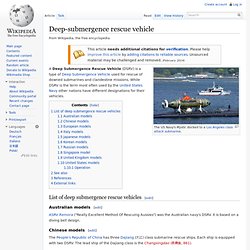
While DSRV is the term most often used by the United States Navy other nations have different designations for their vehicles. List of deep submergence rescue vehicles[edit] Australian models[edit] ASRV Remora ("Really Excellent Method Of Rescuing Aussies") was the Australian navy's DSRV. It is based on a diving bell design. Chinese models[edit] European models[edit] France, Norway and the UK share the NATO Submarine Rescue System programme.
Deep-submergence vehicle. A Deep-submergence vehicle (DSV) is a deep diving manned submarine that is self-propelled.
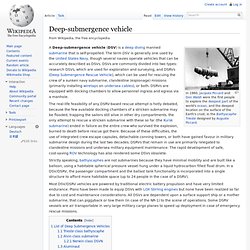
The term DSV is generally one used by the United States Navy, though several navies operate vehicles that can be accurately described as DSVs. DSVs are commonly divided into two types: research DSVs, which are used for exploration and surveying, and DSRVs (Deep Submergence Rescue Vehicle), which can be used for rescuing the crew of a sunken navy submarine, clandestine (espionage) missions (primarily installing wiretaps on undersea cables), or both.
DSRVs are equipped with docking chambers to allow personnel ingress and egress via a manhole. Strictly speaking, bathyscaphes are not submarines because they have minimal mobility and are built like a balloon, using a habitable spherical pressure vessel hung under a liquid hydrocarbon filled float drum. Most DSV/DSRV vehicles are powered by traditional electric battery propulsion and have very limited endurance. Aluminaut. Aluminaut was built in 1964 and was the world's first aluminum submarine.
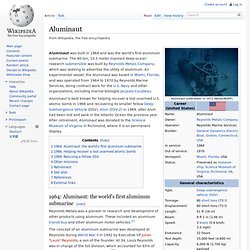
The 80-ton, 15.5 meter manned deep-ocean research submersible was built by Reynolds Metals Company, which was seeking to advertise the utility of aluminum. An experimental vessel, the Aluminaut was based in Miami, Florida, and was operated from 1964 to 1970 by Reynolds Marine Services, doing contract work for the U.S. Navy and other organizations, including marine biologist Jacques Cousteau. 1964: Aluminaut: the world's first aluminum submarine[edit] Reynolds Metals was a pioneer in research and development of other products using aluminum. The concept of an aluminum submarine was developed at Reynolds during World War II in 1942 by Executive VP Julian "Louis" Reynolds, a son of the founder. In 1964, Reynolds had the Electric Boat Division of General Dynamics in Groton, Connecticut build the world's first aluminum submarine. Reynolds had the Aluminaut designed and built as an experiment.
Deepsea Challenger. Deepsea Challenger (DCV 1) is a 7.3 metres (24 ft) deep-diving submersible designed to reach the bottom of Challenger Deep, the deepest known point on Earth.
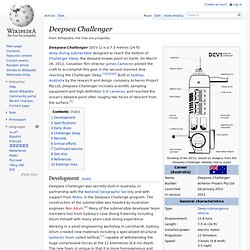
On March 26, 2012, Canadian film director James Cameron piloted the craft to accomplish this goal in the second manned dive reaching the Challenger Deep.[1][2][3][4] Built in Sydney, Australia by the research and design company Acheron Project Pty Ltd, Deepsea Challenger includes scientific sampling equipment and high-definition 3-D cameras, and reached the ocean's deepest point after roughly two hours of descent from the surface.[5] Development[edit] Deepsea Challenger was secretly built in Australia, in partnership with the National Geographic Society and with support from Rolex, in the Deepsea Challenge program.